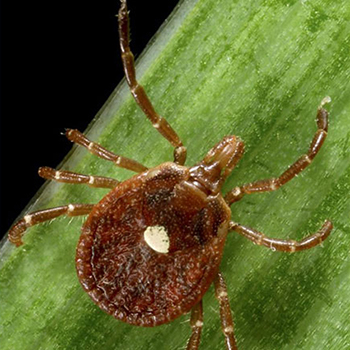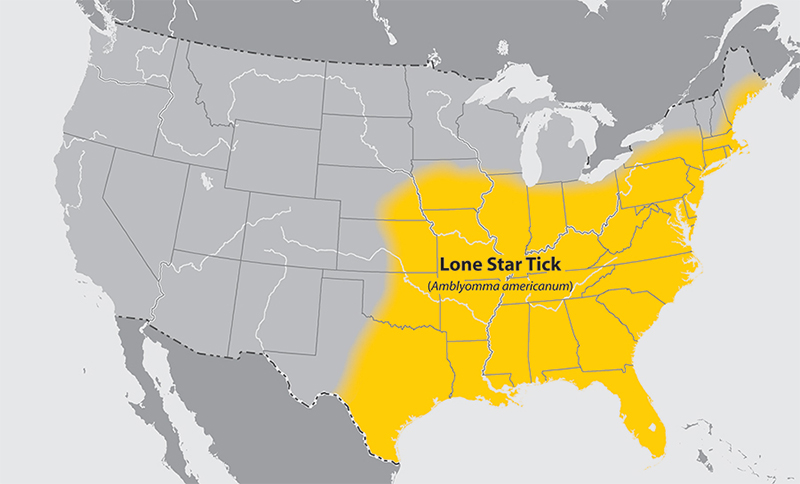




Today's Medicine
Tick That Calls Nebraska and Iowa Home May Cause Red Meat Allergy
Published: June 27, 2019

In Nebraska and Iowa, ticks are an annual warm-weather nuisance.
The pesky bugs pose a threat to humans and animals by spreading Rocky Mountain spotted fever, Lyme disease, Babesiosis and other diseases.
And as if we needed another reason to avoid ticks, they’ve been linked to an allergy to red meat.

Little tick, big deal
Scientists believe that the allergy, known as alpha-gal syndrome, can develop after a bite from the lone star tick.
Here’s how: When the tick bites someone, it transmits a sugar molecule known as alpha-gal that causes the immune system to react. The reaction only becomes evident after the person eats red meat – which contains alpha-gal (fish and poultry don’t usually have the sugar molecule). The reaction can also occur after exposure to a product made from mammals, such as gelatin, milk products or cosmetics.
Alpha-gal allergy symptoms
The symptoms often appear three to six hours after eating red meat. They include:
- Rash
- Hives
- Difficulty breathing
- Drop in blood pressure
- Dizziness or faintness
- Nausea or vomiting
- Severe stomach pain
The symptoms can be mild, severe or even life-threatening. They can ease or disappear over time, especially in the absence of further tick bites. A primary care provider or allergist can determine if you have alpha-gal syndrome. Seek medical help immediately if you are having a severe allergic reaction.
About the lone star tick
The lone star tick is aggressive and is known to bite humans. It gets its name from the white dot – or lone star – visible on the adult female’s back.
The lone star tick is common in the South but can be found throughout the eastern United States and in Eastern Nebraska and much of Iowa. You’re most at risk of being bitten from the early spring to late fall.

Tick bite prevention
The best way to prevent alpha-gal syndrome – or any tickborne disease – is to prevent tick bites. Ticks are most active from April to September. Here’s what to remember.
When outdoors:
- Avoid grassy, brushy, wooded areas. This is home sweet home for ticks
- Wear long sleeves and pants when you can. Light-colored clothing makes ticks easier to spot
- Use Environmental Protection Agency (EPA)-registered insect repellents containing DEET, picaridin, IR3535, oil of lemon eucalyptus, p-Menthane-3,8-diol or 2-undecanone (Use the EPA repellent search tool)
- Treat your clothing and gear with repellent containing 0.5% permethrin
- Treat dogs and cats per your veterinarian’s recommendation
After coming indoors:
- Immediately check for ticks, especially under the arms, in and around the ears, inside the belly button, behind the knees, between the legs, around the waist, and on the hairline and scalp. Don’t forget to check your pets
- Check your clothing and gear for ticks
- Shower
Tick removal
Uh-oh. You found a tick on your skin. Here’s what to do as soon as possible:
- Use fine-tipped tweezers to grab the tick as close to your skin as you can.
- Pull upward with steady, even pressure. Don’t twist or jerk the tick. If the tick’s mouth parts break off and are still in your skin, remove them with clean tweezers. If you can’t remove them, leave them alone and let the skin heal.
- After the tick has been removed, thoroughly clean the bite area and your hands with rubbing alcohol, an iodine scrub or soap and water.
The threat of ticks and the diseases they can carry shouldn’t keep you from enjoying time outside. But if you need further guidance or become ill, contact your primary care provider or the Methodist Physicians Clinic Infectious Diseases Clinic.
More Resources
- Visit cdc.gov/ticks for all things ticks: identification, safety and more
- Mosquitos cause summer trouble, too. Learn more about West Nile virus and its symptoms
- Meet Methodist’s infectious disease specialists


